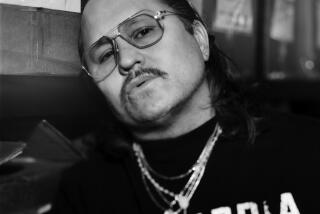Los Angeles Festival: âHOME, PLACE and MEMORYâ A Citywide Arts Fest. : Documentary Evens the Score for Father of Mambo : Movies: Cuban-born actor Andy Garcia documents a concert honoring Israel Lopez Cachao. Itâs Garciaâs directorial debut.
It was an unlikely scene, made possible only perhaps by Cuban-born actor Andy Garciaâs love of Cuban music: a crowd of 5,000 gathering last year at Miamiâs James L. Knight Center to celebrate the music of Israel Lopez Cachao.
As spontaneous as the show itself, Garciaâs filmed account of the rehearsals and the concert will help bring overdue recognition to the man who is Cuban music personified. Garciaâs film, â Cachao: Como su ritmo no hay dos â (âCachao: Like His Rhythm, There Is No Equalâ), will open Wednesday at the Nuart Theatre in West Los Angeles as part of the L.A. Festival.
Although Damaso Perez Prado popularized the mambo dance craze on an international level in the late â40s, Cachao has long been known among Cuban musicians as the father of the mambo. One of the reasons Cachao isnât better known outside of Cuban music circles is his low profile.
âIâm a very quiet man,â Cachao, 74, said recently by phone from his home in Miami. âItâs never bothered me that Iâm not better known . . . but I am happy for all the help this boy Andy Garcia has given me. I love him as if he was my own son.â
Until Garcia crossed his path, Cachao mostly survived by playing birthday parties and obscure Miami restaurants. Cachao, along with his brother Orestes, composed more than 3,000 danzones (a danceable blend of Afro rhythms with Spanish- and French-derived music) in the 1920s, before giving birth to the mambo in 1938 by adding further spice to the danzon . It was a move that would change--or expand--Cuban music forever, setting the scenario for the whole salsa movement.
As significant for Latin pop music as the mambo, but even more ambitious, was Cachaoâs 1957 descargas --actual jazz-style jam sessions with some of Cubaâs best folkloric musicians. With plenty of room to improvise, the descargas produced some of the best Afro-Cuban records ever, collectorsâ items that were ahead of their time and became points of reference for much of the music of future years, not only in the traditional tropical field but in Latin jazz as well.
Despite his significance, Cachao has been virtually ignored by the Cuban exile community in the United States (particularly in Miami, because his African-rooted style was never appreciated by the predominantly white, well-to-do first generation of exiles).
*
âThey said it presented a false image of the Cuban population,â Cachao said. The absence of an Afro-Cuban presence in Miami is eloquent.
In a Wall Street Journal article in August on Garciaâs documentary, Florida International University sociologist Lisandro Perez said that âin Cuban history, that which is African--music, religion, even ways of speaking--is associated with the lowest economic origin. Immigration here has been very heavily influenced by the Cuban elite, people who are not traditionally supporters of Cubaâs African art forms.â
But not all Cuban exiles turn their backs on their former homelandâs Afro-Cuban musical roots.
Guillermo Cespedes, the Cuban-born leader of the San Francisco-based Conjunto Cespedes band, praises both post-revolutionary Nueva Trova and traditional Afro-Cuban music, of which Cachao is the ultimate exponent.
âWhen I hear Cachaoâs bass, I hear African drums,â said Cespedes. âMaybe he doesnât know the difference between Congo, Cameroon and Tanzania rhythms, but his true genius and mastery cannot be disputed.â
After listening to Cachaoâs music for more than 20 years, Garcia has made a directorial debut that couldnât have had more positive effects, both for him and the mambo father.
âIâve only spent five years in Cuba,â said Garcia, âbut it was enough to instill in me the music, the color, the tremendous energy of being a Cuban. With his music and humanity, Cachao represents the best of my country. This is the least I could do for him.â
More to Read
The biggest entertainment stories
Get our big stories about Hollywood, film, television, music, arts, culture and more right in your inbox as soon as they publish.
You may occasionally receive promotional content from the Los Angeles Times.










